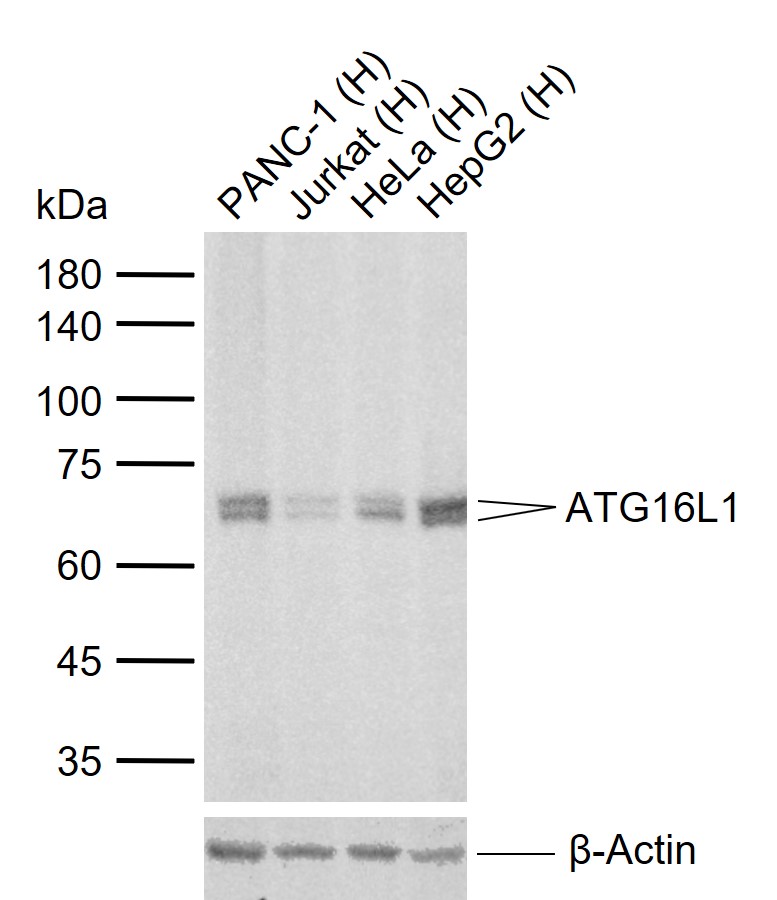
Rabbit Anti-ATG16L1 antibody
A16L1_HUMAN; APG16 like 1; APG16-like 1; APG16L; APG16L beta; ATG16A; ATG16 autophagy related 16 like 1; ATG16 autophagy related 16-like 1 (S. cerevisiae); ATG16 autophagy related 16-like 1; ATG16A; ATG16L; ATG16L1; Autophagy related protein 16 1; Autopha
View History [Clear]
Details
Product Name ATG16L1 Chinese Name 自噬相关蛋白16ARecombinant rabbit monoclonal anti Alias A16L1_HUMAN; APG16 like 1; APG16-like 1; APG16L; APG16L beta; ATG16A; ATG16 autophagy related 16 like 1; ATG16 autophagy related 16-like 1 (S. cerevisiae); ATG16 autophagy related 16-like 1; ATG16A; ATG16L; ATG16L1; Autophagy related protein 16 1; Autophagy-related protein 16-1; FLJ00045; FLJ10035; FLJ10828; FLJ22677; IBD10; OTTHUMP00000164391; OTTHUMP00000164393; OTTHUMP00000165876; OTTHUMP00000165877; WD repeat domain 30; WDR30. Immunogen Species Rabbit Clonality Polyclonal React Species Human, (predicted: Mouse, Rat, ) Applications WB=1:500-1000
not yet tested in other applications.
optimal dilutions/concentrations should be determined by the end user.Theoretical molecular weight 68kDa Cellular localization cytoplasmic Form Lyophilized or Liquid Concentration 1mg/ml immunogen KLH conjugated synthetic peptide derived from human ATG16L1 Lsotype IgG Purification affinity purified by Protein A Buffer Solution 50mM Tris-Glycine(pH 7.4), 0.15M NaCl, 40% Glycerol, 0.01% Sodium azide and 0.05% BSA Storage Shipped at 4℃. Store at -20 °C for one year. Avoid repeated freeze/thaw cycles. Attention This product as supplied is intended for research use only, not for use in human, therapeutic or diagnostic applications. PubMed PubMed Product Detail The protein encoded by this gene is part of a large protein complex that is necessary for autophagy, the major process by which intracellular components are targeted to lysosomes for degradation. Defects in this gene are a cause of susceptibility to inflammatory bowel disease type 10 (IBD10). Several transcript variants encoding different isoforms have been found for this gene.[provided by RefSeq, Jun 2010]
Function:
Plays an essential role in both canonical and non-canonical autophagy: interacts with ATG12-ATG5 to mediate the lipidation to ATG8 family proteins (MAP1LC3A, MAP1LC3B, MAP1LC3C, GABARAPL1, GABARAPL2 and GABARAP) (PubMed:23376921, PubMed:23392225, PubMed:29317426, PubMed:30778222, PubMed:33909989, PubMed:24553140, PubMed:24954904, PubMed:27273576). Acts as a molecular hub, coordinating autophagy pathways via distinct domains that support either canonical or non-canonical signaling (PubMed:29317426, PubMed:30778222). During canonical autophagy, interacts with ATG12-ATG5 to mediate the conjugation of phosphatidylethanolamine (PE) to ATG8 proteins, to produce a membrane-bound activated form of ATG8 (PubMed:23376921, PubMed:23392225, PubMed:24553140, PubMed:24954904, PubMed:27273576). Thereby, controls the elongation of the nascent autophagosomal membrane (PubMed:23376921, PubMed:23392225, PubMed:24553140, PubMed:24954904, PubMed:27273576). Also involved in non-canonical autophagy, a parallel pathway involving conjugation of ATG8 proteins to single membranes at endolysosomal compartments, probably by catalyzing conjugation of phosphatidylserine (PS) to ATG8 (PubMed:33909989). Non-canonical autophagy plays a key role in epithelial cells to limit lethal infection by influenza A (IAV) virus (By similarity). Regulates mitochondrial antiviral signaling (MAVS)-dependent type I interferon (IFN-I) production (PubMed:22749352, PubMed:25645662). Negatively regulates NOD1- and NOD2-driven inflammatory cytokine response (PubMed:24238340). Instead, promotes with NOD2 an autophagy-dependent antibacterial pathway (PubMed:20637199). Plays a role in regulating morphology and function of Paneth cell (PubMed:18849966).
Subunit:
Homooligomer. Interacts with ATG5. Part of either the minor and major complexes respectively composed of 4 sets of ATG12-ATG5 and ATG16L1 (400 kDa) or 8 sets of ATG12-ATG5 and ATG16L1 (800 kDa).
Subcellular Location:
Cytoplasm
Tissue Specificity:
Expressed in right hemisphere of cerebellum and 147 other tissues
DISEASE:
Genetic variations in ATG16L1 are associated with susceptibility to inflammatory bowel disease type 10 (IBD10) [MIM:611081]. IBD is characterized by a chronic relapsing intestinal inflammation. IBD is subdivided into Crohn disease (CD) and ulcerative colitis phenotypes. IBD10 individuals show the phenotype characteristic to CD. It may involve any part of the gastrointestinal tract, but most frequently the terminal ileum and colon. CD is commonly classified as autoimmune disease.
Similarity:
Belongs to the WD repeat ATG16 family.Contains 7 WD repeats.
SWISS:
Q676U5
Gene ID:
55054
Database links:
- Entrez Gene: 55054 Human
- Entrez Gene: 77040 Mouse
- Entrez Gene: 363278 Rat
- Omim: 610767 Human
- SwissProt: Q676U5 Human
- SwissProt: Q8C0J2 Mouse
- Unigene: 529322 Human
- Unigene: 272972 Mouse
- Unigene: 456099 Mouse
Product Picture
Lane 1: Human PANC-1 cell lysates
Lane 2: Human Jurkat cell lysates
Lane 3: Human HeLa cell lysates
Lane 4: Human HepG2 cell lysates
Primary: Anti-ATG16L1 (SLM-60770R) at 1/1000 dilution
Secondary: IRDye800CW Goat Anti-Mouse IgG at 1/20000 dilution
Predicted band size: 68 kDa
Observed band size: 66,68 kDa
References (0)
No References
Bought notes(bought amounts latest0)
No one bought this product
User Comment(Total0User Comment Num)
- No comment



 +86 571 56623320
+86 571 56623320
 +86 18668110335
+86 18668110335

